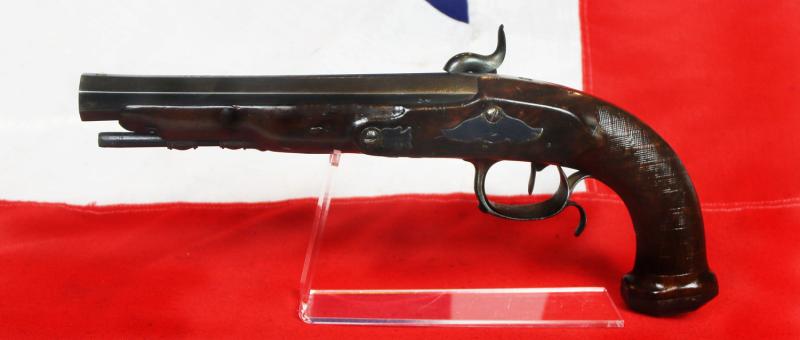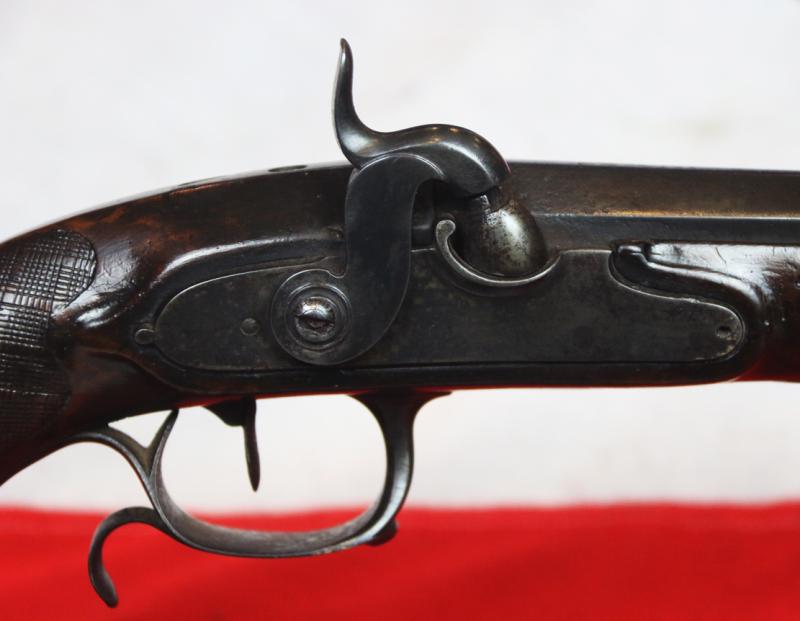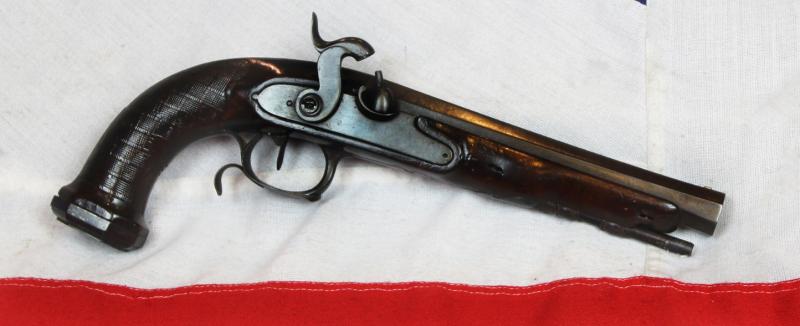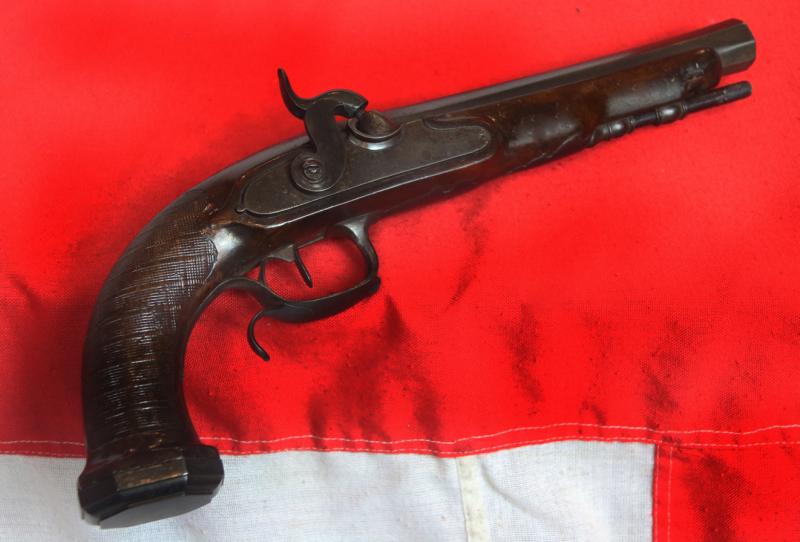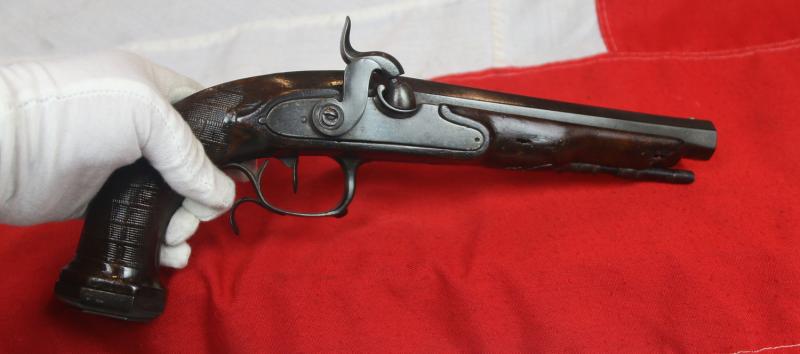A Fabulous Circa 1808, A Year XII Silex Pistol for General Staff Officers, Octagonal Rifled Barrel in 17 mm calibre, Napoleonic Period Pistol By Napoleon’s Personal Gunsmith,The Great Jean Le Page of Paris
A Napoleonic pistol made by one of the greatest and collectable makers of France. Chequered grip, octagonal butt cap, octagonal barrel heavy scroll engraved with Le Page of Paris, flared muzzle octagonal barrel with multi groove rifling. Converse silex action, to enable ignition in foul weather.
The first modern use of a General Staff was in the French Revolutionary Wars, when General Louis-Alexandre Berthier (later Marshal) was assigned as Chief of Staff to the Army of Italy in 1795. Berthier was able to establish a well-organised staff support team. Napoleon took over the army the following year and quickly came to appreciate Berthier's system, adopting it for his own headquarters, although Napoleon's usage was limited to his own command group.
The Staff of the Grande Armée was known as the Imperial Headquarters and was divided into two major sections: Napoleon's Military Household and the Army General Headquarters. A third department dependent on the Imperial Headquarters was the office of the Intendant Général (Quartermaster General), providing the administrative staff of the army.
Made and used by a staff officer, from the period of Napoleon’s Grand Armee. The Grand Armee was the main military component of the French Imperial Army commanded by Emperor Napoleon Bonaparte during the Napoleonic Wars. From 1804 to 1808, it won a series of military victories that allowed the French Empire to exercise unprecedented control over most of Europe. Widely acknowledged to be one of the greatest fighting forces ever assembled, however, it suffered enormous losses during the disastrous invasion of Russia in 1812, after which it never recovered its strategic superiority.
The Grande Armée was formed in 1804 from the L'Armée des côtes de l'Océan (Army of the Ocean Coasts), a force of over 100,000 men that Napoleon had assembled for the proposed invasion of Britain. Napoleon later deployed the army in Central Europe to eliminate the combined threat of Austria and Russia, which were part of the Third Coalition formed against France. Thereafter, the Grande Armée was the principal military force deployed in the campaigns of 1806/7, the French invasion of Spain, and 1809, where it earned its prestige, and in the conflicts of 1812, 1813–14, and 1815. In practice, however, the term Grande Armée is used in English to refer to all the multinational forces gathered by Napoleon in his campaigns.
Upon its formation, the Grande Armée consisted of six corps under the command of Napoleon's marshals and senior generals. When the Austrian and Russian armies began preparations to invade France in late 1805, the Grande Armée was quickly ordered across the Rhine into southern Germany, leading to Napoleon's victories at Ulm and Austerlitz. The French Army grew as Napoleon seized power across Europe, recruiting troops from occupied and allied nations; it reached its peak of one million men at the start of the Russian campaign in 1812,3 with the Grande Armée reaching its height of 413,000 French soldiers and over 600,000 men overall when including foreign recruits.4
In summer of 1812, the Grande Armée marched slowly east, and the Russians fell back with its approach. After the capture of Smolensk and victory at Borodino, the French reached Moscow on 14 September 1812. However, the army was already drastically reduced by skirmishes with the Russians, disease (principally typhus), desertion, heat, exhaustion, and long communication lines. The army spent a month in Moscow but was ultimately forced to march back westward. Cold, starvation, and disease, as well as constant harassment by Cossacks and Russian partisans, resulted in the Grande Armée's utter destruction as a fighting force. Only 120,000 men survived to leave Russia (excluding early deserters); of these, 50,000 were Austrians, Prussians, and other Germans, 20,000 were Poles, and just 35,000 were French.5 As many as 380,000 died in the campaign.6
Napoleon led a new army during the campaign in Germany in 1813, the defence of France in 1814, and the Waterloo campaign in 1815, but the Grande Armée would never regain its height of June 1812. In total, from 1805 to 1813, over 2.1 million Frenchmen were conscripted into the French Imperial Army
Jean Le Page continued the success of his predecessors as gunsmith to the House of Orleans, King Louis XVI, of the First Consul Bonaparte and then Emperor Napoleon I and King Louis XVIII. The factory is famous for its pistols, guns, luxury white arms and page swords during the First French Empire. During this era, many technical innovations were made such as over oxygenated powder in 1810, a water resistant gun in 1817, and invented the fulminate percussion system for firearms which replaced the flintlock.
Jean Le Page cemented the company’s reputation and position in history. As a gunsmith he is mentioned in numerous pieces of literature, and the firearms produced during this period are those most sought after and displayed in museums and the like, particularly due to their often famous provenance.
As a purveyor of arms to kings he brought in an extremely prestigious clientele and this includes Armand Augustin Louis de Caulaincourt, Duke of Vincence, baron Gaspard Gourgaud, the Marshall Emmanuel de Grouchy, General Charles de Flahaut, the Marchioness Catherine-Dominique de Pérignon, the Marshall André Masséna, Duke of Rivoli, Baron Daru, General Carlo Andrea Pozzo di Borgo, and the perfumier Jean-François Houbigant, among others.
Many pieces bear testimony to this sumptuous period, Jean Le Page "is, without doubt, the imperial gunsmith most quoted both in literary texts and in arms notices exhibited in museums". A shooting gun for Louis Philippe II, Duke of Orléans (future Philippe Égalité) is presented to the Museum of the Porte de Hal in Brussels. First Consul Bonaparte's sword is exhibited at the Château de Malmaison. The Musée de la Chasse et de la Nature in Paris also has several beautiful Le Page pieces including two of Emperor Napoleon I's shooting guns belonging to a series made in 1775 for King Louis XVI and modified around 1806 ; a silex gun that had belonged to King Louis XVIII and a nécessaire box containing a pair of silex guns for children, a gift from King Charles X to the Duke of Bordeaux, future Count of Chambord
The pistol has had an old contemporary thin crack repair at the buttstock, replaced rammer
Code: 20866
1675.00 GBP


